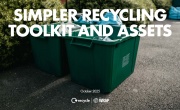European waste industry calls for 'pull' mechanisms to advance circular economy
Members of the European Federation of Waste Management and Environmental Services (FEAD) yesterday (24 October) called on EU institutions to implement an appropriate framework of ‘pull’ measures to complement legally binding targets on recycling and landfill in advance of the next trilogue meeting on the Circular Economy Package (CEP), which took place yesterday (25 October).
FEAD represents the private waste and resource management industry across Europe, and the members have called for the development and implementation of demand-side mechanisms to ensure that the ambition of the EU’s CEP is realised.

Through the right political framework, allied with appropriate economic incentives and continued and intensified dialogue between all the actors in the value chain, FEAD members hope to further sustainable production and consumption patterns and increase the uptake of recycled materials.
Commenting on the announcement, FEAD President Jean-Marc Boursier said: “Market forces alone have not been sufficient to ensure sufficient uptake of certain recycled materials. We need a long term and ambitious policy framework to provide legal certainty, thereby encouraging investments by FEAD companies in more efficient waste and resource management techniques, in line with the waste hierarchy.”
FEAD Secretary General, Nadine De Greef, added: “The eco-design of products incentivized by an extended producer responsibility will substantially reduce their environmental impact. A toolbox of legal and economic measures together with an intensified cooperation between all actors across the value chain are required to make the transition to a circular economy happen.”
In light of the stated desire to see the introduction of a standardised toolbox of legal and economic measures, FEAD has made several recommendations on what should be included in such a toolbox:
-
An optimized collection, sorting and recycling system should be in place to increase the quantity and quality of recycled materials;
-
Levies should be put on non-recyclable materials;
-
A minimum recycled content in selected products should become legally binding and part of public tenders;
-
Legislation should stimulate the uptake of secondary raw materials to make them competitive with virgin materials on the market;
-
Eco-labelling rules should be harmonised to incorporate indications of recycled content and recyclability to raise consumers’ awareness; and
-
Externalities associated with the extraction and processing of virgin raw materials should be factored into their price. Externalities avoided by the recycling sector (CO2 reduction, energy savings) should be recognized.
The desire to see a coherent and effective set of pull mechanisms has been growing over recent years across Europe. At last year’s Resourcing the Future 2016 Conference, the then Chief Executive of CIWM, Steve Lee, stated that the circular economy must become a value chain with enough pull through the supply chain created by landfill diversion and increased recycling, suggesting measures such as green public procurement, VAT variations and targets for recycled content.
Going further back, in November 2015, the Trade Association Group (TAG) called on the European Commission to consider the pull mechanisms required to stimulate demand for materials pushed out of landfill, reiterating the stance of an earlier FEAD letter calling for binding recycling and landfill diversion targets to be accompanied by effective pull mechanisms.






